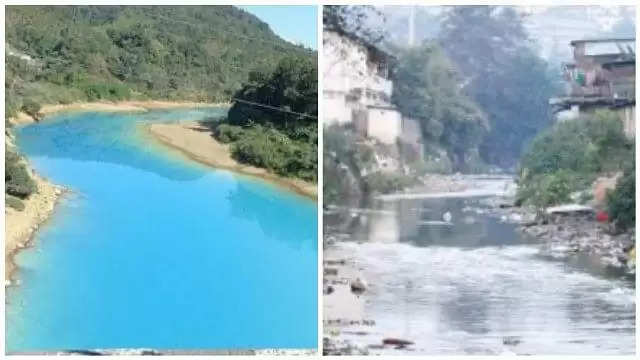The Dead and Dying Rivers of Meghalaya — Who are the culprits?

SHILLONG, March 20 2017: The world is talking about global warming and the predictable catastrophic outcomes which is likely going to transpire if this global problem is not resolved.
Humans' endless wants and the urgent need to strive ahead in this competitive world, though not ignoring the fact that increased production is the need of the hour to feed billions and billions of mouths, has but ravaged and destroyed the environment to the point of no return.
Coming close to home, if one asks a question as to why the tag 'Keep Shillong/Meghalaya clean and green' will not serve its purpose, the answer is simply – the will to safeguard is not as strong as the will to destroy.
Meghalaya has witnessed massive devastation of environment. Take Jaintia Hills for example. Its hills, its valleys, its rivers are victims of human illegal activities which has a direct impact on the environment. Rat hole mining sans proper scientific observations has reduced this region to a barren wasteland.
Like environmentalist HH Mohrmen once said, "The rivers of Jaintia Hills are dead." Thanks to unscientific coal mining and rampant and uncheck illegal operation of industries which releases their effluence to the river bodies.
On March 20, Meghalaya Chief Minister Dr Mukul Sangma informed the house during the ongoing budget session that 15 companies, including 10 cement producing factories, constitute the major polluting units in the state.
ALSO READ: Meghalaya: NGT imposes ban on illegal activities along Jowai's lifeline — Myntdu River
He informed that apart from the cement producing units, three ferro alloy companies, one power plant and one brewery were also on the offending list. Seven of these cement companies are based in limestone rich Jaintia Hills districts. Three other cement companies, one each in East Khasi Hills, East Garo Hills and in Jaintia Hills district, have also been listed by the government as major polluting industries.
The Mawmluh Cherra Cement Ltd, RNB Cements Ltd, Star Cement Ltd, Star Cement Meghalaya Ltd, Adhunik Cement, Amrit Cement, JUD Cement, Hill Cement, Green Valley Industries and Virgo Cement are the major polluting industries. Of these, the Mawmluh Cherra Cement Ltd. in East Khasi hills district is a state-owned unit.
Three ferro-alloys companies, the Shyam Century Ferrous, Maithan Alloys and Shakam-bari Ferrous Ltd, are also among the major pollutants. The Meghalaya Power Limited that develops and operates an 8 MW and a 43 MW thermal power plant providing electricity to Star Cement company is also among the polluting industries.. TMJ Breweries in Ribhoi district is also on the offending list, the CM said adding that the brewery has set up an effluent treatment plant for checking water pollution.
ALSO READ: The fate of the four major rivers of Assam marked as 'Polluted'!
A 2008 investigation report on the contamination of Lukha river by the Meghalaya State Pollution Control Board (MSPCB) indicated that Lukha was polluted and had turned blue as the its tributary, the Lunar river was highly acidic and reacted with the limestone effluents causing the bluish tint in the river.
Again on 2012 report by the MSPCB attributed acid effluents from coal mines as the major probable causes of water pollution in the area.
Recently, while expressing concerns over the uncontrolled and unregulated pollution of water bodies in India, the Supreme Court's direction to the State Pollution Control Boards (SPCBs) to initiate stringent action against polluting industrial units across the country.
A division bench of the apex court, headed by Chief Justice J S Khehar has directed the SPCBs to issue notices to all polluting industries to install effluent treatment plants within the next three months and if they fail to do so, to disconnect power supplies and shut them down till the plants are erected.
While referring to this notice, Meghalaya Chief Minister said the government expects compliance from all concerned as per the Supreme Court order to control pollution even as he said that all these companies have real time monitoring system installed.
ALSO READ: Meghalaya, a living example of the so-called 'Green Community'- But, for how long?
The significance of the SC's intervention at this point in time can be gauged from the fact that the latest assessment by WaterAid, an international organisation working for water sanitation and hygiene, shows that an alarming 80% of India's surface water is polluted.
Here, the role of state governments and local bodies will be vital in enforcing the order.
But, overall, as SPCBs are notorious for dragging their feet in acting against the culprits, there is growing need for the court to set up a monitoring cell under its supervision, so that even common people can send in their complaints if the orders are not complied with.
By Ibankyntiew Mawrie with inputs from Deccan Herald
Images: File Photos

















